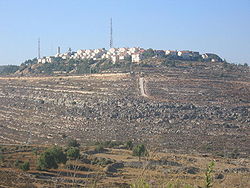| Revision as of 21:19, 13 September 2010 view sourceHaberstr (talk | contribs)Extended confirmed users5,833 edits Added sentence intended as compromise on legality of settlements← Previous edit | Revision as of 22:25, 13 September 2010 view source Shuki (talk | contribs)Extended confirmed users11,955 edits duplicate sentence. Not that I agree, but avoiding edit war in hope of cooler minds prevailing, but removing sloppinessNext edit → | ||
| Line 17: | Line 17: | ||
| }} | }} | ||
| '''Psagot''' ({{lang-he-n|פְּסָגוֹת}}, ''lit.'' Peaks) is a ] ] in the ]. Located near ], it falls under the jurisdiction of ]. The offices of the regional council are located in Psagot.<ref name="hareuveni" /> In 2008 it had a population of 1,623.<ref name="cbs-loc" / |
'''Psagot''' ({{lang-he-n|פְּסָגוֹת}}, ''lit.'' Peaks) is a ] ] in the ]. Located near ], it falls under the jurisdiction of ]. The offices of the regional council are located in Psagot.<ref name="hareuveni" /> In 2008 it had a population of 1,623.<ref name="cbs-loc" /> | ||
| ==Geography== | ==Geography== | ||
| Line 23: | Line 23: | ||
| ==History== | ==History== | ||
| Psagot was established in 1981 by a ] of residents of the ] neighborhood of ]. Although the ]i government disagrees,<ref> Israel Ministry of Foreign Affairs, November 2007</ref> most legal authority considers Israeli settlements in the West Bank, including Psagot, illegal.<ref>Regarding international organizations and courts of law, see ; regarding the UN, see UN General Assembly resolution 39/146, 14 December 1984; UN Security Council Resolution 446, 22 March 1979; and International Court of Justice Advisory Opinion, 9 July 2004, Legal Consequences of the Construction of a Wall in the Occupied Palestinian Territory, para 120; Regarding the European Union position, see ; for Canada's position, see </ref> | |||
| Psagot was established in 1981 by a ] of residents of the ] neighborhood of ]. Psagot is illegal under international law.<ref name="bbc" /><ref>Whitacker, Brian. The Guardian. 3 September 2001</ref> | |||
| ==Economy== | ==Economy== | ||
Revision as of 22:25, 13 September 2010
Place in Israel| Psagot | |
|---|---|
 | |
| Country | Israel |
| Council | Mateh Binyamin |
| Region | West Bank |
| Affiliation | Amana |
| Founded | 1981 |
| Founded by | Beit VeGan residents |
| Population | 1,623 |
Psagot (Template:Lang-he-n, lit. Peaks) is a communal Israeli settlement in the West Bank. Located near Ramallah, it falls under the jurisdiction of Mateh Binyamin Regional Council. The offices of the regional council are located in Psagot. In 2008 it had a population of 1,623.
Geography
Psagot is located on the peak of Mount Tawil, hence its name. It can be accessed from Highway 60 from the north and south.
History
Psagot was established in 1981 by a gar'in of residents of the Jerusalem neighborhood of Beit VeGan. Although the Israeli government disagrees, most legal authority considers Israeli settlements in the West Bank, including Psagot, illegal.
Economy
Psagot winery was founded by Na’ama and Ya’akov Berg, who planted vineyards in 1998. In addition to a modern barrel cellar, some of the oak barriques are stored in a cave dating back to the Second Temple. The winery’s top wine is a Bordeaux blend named Edom. Regular varietal wines are produced in the Psagot series and there is also a Port-style wine. In 2007 and 2008, the winery produced 65,000 bottles annually. Other wineries exist around Psagot, and the Yesha Council hopes to make them a tourist attraction.
References
- ^ HaReuveni, Immanuel (1999). Lexicon of the Land of Israel. Miskal – Yedioth Ahronoth Books. p. 795. ISBN 965-448-413-7.
- "Locality File" (XLS). Israel Central Bureau of Statistics. 2008. Retrieved 2010-06-22.
- Israel, the Conflict and Peace: Answers to frequently asked questions Israel Ministry of Foreign Affairs, November 2007
- Regarding international organizations and courts of law, see ; regarding the UN, see UN General Assembly resolution 39/146, 14 December 1984; UN Security Council Resolution 446, 22 March 1979; and International Court of Justice Advisory Opinion, 9 July 2004, Legal Consequences of the Construction of a Wall in the Occupied Palestinian Territory, para 120; Regarding the European Union position, see ; for Canada's position, see
- Psagot Winery at Rogov's Reviews
- Settler vineyards take root in West Bank BBC. 17 June 2009